
AI recommendations displayed on the screen.
Text by Reiko Imamura
At NEXPERIENCE workshops, there’s a process where all participants share their ideas. It’s a process where we think together about what challenges clients and end users are experiencing and what new solutions and services they need.
In our contemporary world with its labyrinthine tangle of problems, jump-starting creativity unfettered by existing ideas holds the key to its solutions. But people from the same industry meeting to scratch their heads tend to generate ideas only within the scope of their imagination. In the face of such a predicament, we wondered whether we could reach a breakthrough in solving social issues if we integrate knowledge from many different industries with the key concept of cross-industry analogies. We thought, why not take advantage of Hitachi being a multi-industry conglomerate for that purpose.
What we developed was a workshop tool that supports the ideation process by studying success stories from different industries. Experts had convened before to share knowledge, but it was difficult to provide these opportunities at every workshop. Therefore, we made use of AI to search from a comprehensive Hitachi Group database with over one thousand cases from the last five years and recommended analogous examples. The point is to move away from an industry’s conventional wisdom and jump-start creativity by examining cross-industry cases that at first appear unlikely to offer inspiration.
For example, when a team of participants was tasked with ideating a new IoT home appliance service, they brainstormed how, in three years, they might go beyond offering a mere appliance and instead collaborate with a different industry. In the workshops, the tool’s AI picks up the conversation through speech recognition in real time, and it searches and recommends past cases and related affairs that may inspire the participants. In one instance, having picked up on the issue of lack of time for hobbies in daily life, the AI recommended an example about work style reform aimed at reducing stress and revitalizing the workplace. The example focused on visualizing data on stress in the workplace, but the AI had replaced “workplace” with “household” to make the recommendation. So inspired, the team devised a solution to visualize the stress associated with housework using IoT home appliances, so households could better distribute responsibilities among family members.
How does the AI recommend such surprising content? The answer is in how it performs the keyword search. Instead of just pulling up the desired keywords, the AI is programmed to cast a wider net. For example, if a team member says in Japanese, “It’s hard to push a stroller on an eki [train station] platform,” ordinary speech recognition would pick up on and search only the spoken words. This AI, however, would expand the Japanese eki to not only the English station but also to bus or tram stop or even interchange. The terms vary across industries, so it’s like creating a cross-industry thesaurus. Consider, what in the healthcare industry may be called safety is, in finance, insurance, and so on.
The AI will pull up word associations with completely different meanings well beyond the capabilities of human imagination. This can jump-start our creativity.
The screen on which the AI’s recommendations are displayed is fairly simple. The title is made to catch the eye and the list of keywords makes it easy for the viewer to get a rough idea of the case. People in all sorts of capacities participate in these workshops. Different things are going to stick out to researchers, designers, and managers, so we made three categories—story, technology, and service pattern—by which to organize the information in a way that’s easy to understand at a glance.
In addition to the development of an AI-enabled tool, Hitachi designed a workshop to go with it as a set. A workshop can achieve results only if someone drafts an exhaustive scenario with a series of steps of how to motivate participants and what they will speak about when using the tool. Unlike the standard experience where team members talk animatedly with each other, a microphone is placed on the table and the AI’s artificial voice is heard instead in this session. The activity will gain steam in the atmosphere that the childlike AI takes part in the workshop, eagerly trying to make suggestions to assist the participants.
With the help of new devices, cross-industry ideation has increased twofold. Not only did the participants have fun brainstorming, but they also had a chance to learn how people in other industries think. At Hitachi, workshops using this tool will continue to be held and are expected to be well-established as a process unique to NEXPERIENCE.